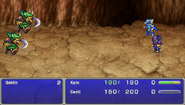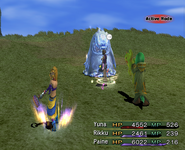Template:See Also The battle systems are the core engine for battles in the Final Fantasy series. The first few games had simple battle systems that developed as the series grew. The newer games have more intricate battle systems that involve attention from the player. They generally make up a large part of the game and allow the party to increase their strength, learn new abilities, gain new items and advance in the storyline.
A typical battle screen displays the party and the enemies with a background to show the surrounding area. There is a list of the enemies, a list of party members, and the basic statistics used in combat for each unit that can encompass HP, MP, and various other gauge levels.
The series started with a turn-based battle system, that evolved into Active Time Battle (ATB). Mainline games from Final Fantasy IV to Final Fantasy IX used ATB, and every mainline game from Final Fantasy X through to Final Fantasy XIII used a unique battle system. Final Fantasy XIV used a similar MMORPG system to Final Fantasy XI, while Final Fantasy XV is the first game to use a battle system that is full real-time action.
Types
Traditional turn-based
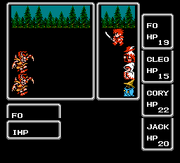
The first battle system from Final Fantasy.
The original turn-based battle system was designed by Akitoshi Kawazu and Hiroyuki Ito.[1][2] It is used in the first three Final Fantasy games and Final Fantasy: The 4 Heroes of Light. When encountering random enemies or bosses, the field screen fades out into a battle screen. Each turn, party members are chosen to perform an action from their available options (such as Fight, Magic, or Items).
When all party members have chosen their action, whoever has the highest Agility or Speed statistic acts first. The battle round ends when the enemy or party member with the lowest statistic performs their action. Thus, Agility does not determine how often a character can attack so much as how many actions the units perform in a single turn, namely, how many hits with a weapon the member lands, and in what order they attack.
Bravely Default uses a unique battle system where characters can use the actions Brave and Default. Default allows the selected character to skip a turn to gain one BP, and the Brave command lets the character use the gained BP to move up to four times. Players can move twice without Defaulting and go into negative BP, allowing for the character to have multiple turns. However, this will give the enemy multiple turns as well.
Active Time Battle
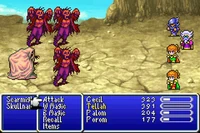
ATB as seen in the GBA version of Final Fantasy IV.
The Active Time Battle (ATB) system was designed by Hiroyuki Ito and was the first battle system to receive a dedicated name. It shares many attributes with the original system, but adds the dimension of timing for commands. An ATB gauge tracks when party members are going to act. When the gauge is full, members perform an action. In later games and/or remakes, some actions have an additional wait time, such as casting spells or using special abilities.
After the action is executed, the ATB gauge is depleted and must recharge. The rate which the gauge recharges typically correlates to the Speed stat of the character and the Battle Speed, which can be adjusted in the config. Thus combatants do not always get an equal number actions on a turn. ATB introduced attack formations, an element on how the battle itself is played out. For example, Preemptive Strike and Back Attack change how the battle begins by giving an initial edge to one side or the other by giving them an extra turn or changing the party order to disadvantage them. Side Attack and Pincer Attack change the entire combat, providing more opportunities for strategy.
There are usually two settings to ATB: Active mode and Wait mode. In Active mode, time flows regardless of what is going on in game. In Wait mode, time stops when the player is navigating menus. Final Fantasy VII had a third mode called Recommended, which was a mix of the two. These two modes are usually the closest thing to changing the in-game difficulty, as some events can be stalled to an extent in Wait mode. The best example is stalling the status ailment Doom, in which the player can let long actions go on in a menu to pause the counter, only to quickly input actions and stop in another menu later. What could seem like "10 seconds" could be extended to minutes.
The first game to make use of this system was Final Fantasy IV, but it did not feature the ATB meter in the SNES and PlayStation versions. The ATB meter was introduced in Final Fantasy V, and the option to skip turns debuted in Final Fantasy VI. Main installments from its introduction through Final Fantasy IX made use of the ATB system, and it returned in a modified form for Final Fantasy X-2.
Final Fantasy X-2 added several new features to the ATB system: Chaining attacks allows the player to deal more damage, and free battle positions can be exploited with having a character perform a physical ability behind the target to strike for double damage. The player spherechange between dresspheres, or job classes, during a battle allowing for more flexibility than previous job systems offered.
Several other games use systems which derive from ATB, or contain elements from it. The Final Fantasy XII Active Dimension Battle system, and the Remake release of Final Fantasy VII[3], both contain the ATB gauge, though they are not command based in the same sense.
Square filed a Japanese patent application related to the ATB system on July 16, 1991 and a corresponding US application on March 16, 1992. One Japanese patent (JP2794230) and two US patents (US5390937 and US5649862) were granted based on these applications. Another iteration of the ATB system features in the Squaresoft title Template:Wikia, where it is dubbed Active Time Battle ver. 2. It was created by Akihiko Matsui, who is also the creator of Real Time Battle (RTB) used in Final Fantasy XI and Final Fantasy XIV.
Charge Time Battle
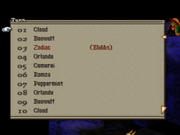
The Charge Time Battle system, dictating the order of turns.
Final Fantasy Tactics introduced the Charge Time Battle (CTB) system, created by Hiroyuki Ito and Yasumi Matsuno. In this system, Charge Time (CT) meters fill up to 100 to allow each unit to take action. The system has since been used in a modified form in Final Fantasy Tactics Advance and Final Fantasy Tactics A2: Grimoire of the Rift.
Conditional Turn-Based Battle
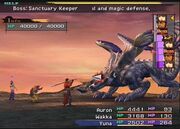
The CTB from Final Fantasy X. Note the Act List on the right.
The Conditional Turn-Based Battle system, or the Count Time Battle system in Japan, designed by Toshiro Tsuchida is used in Final Fantasy X. CTB is a turn-based system which does not operate in rounds, instead it uses an Act List that is affected through various means and thus does not guarantee that each participant in a battle will have an equal number of turns. Units with higher speed take more turns than slower ones, making speed more important than in other turn-based battle systems. Players can substitute party members mid-battle adding a new level of strategy.
Spells and abilities (such as Haste or Overdrives) modify the Act List, as some abilities require a longer cool down time. Weaker abilities tend to require less cool down time, thus introducing a trade-off between speed and power. When a character's turn begins all action stops while the player decides upon an action. This shifts the focus from reflexes and quick decision-making to strategy and careful planning.
The Conditional Turn-Based Battle system is the battle system of Final Fantasy Legends: Toki no Suishō.
Real Time Battle
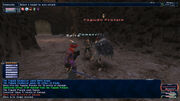
A Real Time Battle in Final Fantasy XI between a party of two players and one foe.
The Real Time Battle (RTB) system was introduced in Final Fantasy XI and was designed by Akihiko Matsui, who created the battle system for Chrono Trigger. The RTB system replaces the random encounter that has featured in past Final Fantasy games, and instead monsters freely roam areas and are seamlessly engaged.
As the battle takes place without a separate battle screen loading one is free to move around the landscape during battles, interact with other players or avoid battles altogether. Monsters may attack players without provocation, retaining a hint of random encounters. Characters start attacking automatically once they are in combat with an enemy, and special commands and magic can be input any time. Many items, spells and abilities used during battle have a casting time or delay to use once activated, similar to Active Time Battles.
An evolved form of the RTB system is used in Final Fantasy XIV.
Active Dimension Battle
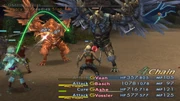
Active Dimension Battle in Final Fantasy XII.
The Active Dimension Battle (ADB) system is the main evolution of the Active Time Battle (ATB) system. The system was designed and directed by Hiroyuki Ito, with the actual programming being done by Takashi Isowaki under Takashi Katano.[4] ADB has so far only been used in Final Fantasy XII. The ADB system eliminates random battles; the battles take place on the field with no separate battle screen and as such there is no transition between exploration and battle.
The player has the choice of confronting enemies or keeping their distance and exploring the area. Some creatures will not instigate battle with the party unless the party attacks first, and some enemies encountered on the field will be far too powerful when the party first meets them, adding an element of risk to an all-out-attack methodology when first exploring areas. The player has control over a single party member's movement while engaged in battle and the distance between party members and enemies influences battles as various spells and abilities have an Area of Effect (AoE), meaning party members and enemies need to be within a certain range of each other for the abilities to hit.
Due to the addition of the Turbo mode, which is activated by holding down the ![]() button, the iteration of ADB used in Final Fantasy XII International Zodiac Job System is the fastest battle system in the series.
button, the iteration of ADB used in Final Fantasy XII International Zodiac Job System is the fastest battle system in the series.
Command Synergy Battle
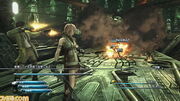
A Command Synergy Battle in Final Fantasy XIII.
Command Synergy Battle (CSB) is the battle system in Final Fantasy XIII and Final Fantasy XIII-2 designed by Toshiro Tsuchida, the creator of the Conditional Turn-Based Battle (CTB) system. It derives the flow of time from ATB as each party member has a unique ATB gauge that acts like an action point meter divided up into equal sections (a similar system was used in Enix's game Robotrek). Each action consumes a portion of the ATB gauge; for example, attacking consumes one point, while casting a powerful spell consumes three. Commands can be chained so as long as there are enough ATB segments. When the player decides on what commands to take, they press another button to execute the commands. If the player executes the chained commands without filling all ATB slots, the unused slots will be filled at the start of the next turn.
Unlike regular ATB, the player is only able to control the actions of the party leader. The party begins with two ATB segments, and each gain a segment through story progression at the end of Chapter Two, subduing their respective Eidolon, obtaining the unique ATB crystal on their Crystarium tree, and synthesizing a third tier weapon, for a maximum of six segments. In Final Fantasy XIII-2 all ATB segments can be gained through completing a Crystarium Level and selecting to gain an extra segment. A final segment can be obtained through ultimate weapons. In both games, obtaining extra segments means that although the entire gauge takes longer to recharge, individual segments refill faster. At six ATB segments, each segment recharges almost twice as fast as having two.
At the end of the battle the player is judged on a rating of zero to five stars in the Battle Results screen. In Final Fantasy XIII, the rating is based on a comparison between the party's power and battle duration, while in Final Fantasy XIII-2, only battle duration is ranked. Battle ranking determines rate and quality of spoils and in some specific battles, obtaining the highest rank will unlock its trophy.
Style-Change Active Time Battle

Lightning changing her Schema mid-battle.
Style-Change Active Time Battle (SATB) is the battle system in Lightning Returns: Final Fantasy XIII. It is an evolved version of Command Synergy Battle and created by Yuji Abe.
The base idea of the battle system was to shuffle through equipment and ability sets on the go, while retaining the action style of Command Synergy Battle. An early glimpse of this battle system is present in the "Lightning's Story: Requiem of the Goddess" DLC scenario for Final Fantasy XIII-2.
As opposed to Command Synergy Battle where a party of maximum three members could participate, the Style-Change Active Time Battle allows for a single character to be present on the battlefield. Lightning, the sole playable character of Lightning Returns: Final Fantasy XIII, can shift between three schemata to which a player can assign various equipment pieces and abilities. Each schema has an ATB gauge which fills over time. Each action costs ATB points and to execute an ability one of four buttons on the right side of the pad needs to be pushed.
As another new element, Lightning can remove various pieces of her enemy target, such as tails and horns, to gain additional drops after a battle.
Active X Battle
The Active X Battle (AXB) system, pronounced "Active Cross Battle", is the battle system of Final Fantasy XV and was designed and directed by Hajime Tabata. The AXB system is said to be mostly similar to the battle system used in Final Fantasy Type-0.[5]
In this battle system players come into contact with enemies on the field. When an enemy targets the player an encounter gauge appears on the screen, giving the player chance to flee before it fills and avoid the battle. The player can also initiate battles with the enemies on the field without waiting for them to target them first. There is a chance nearby enemies from the field will join in the battle once one has been initiated.
The player controls only one character, Noctis, with the other party members being controlled by the AI. The player's actions are assigned to the controller's face buttons, with one button assigned for special moves, one for attacking and one for defending and evading. Defending, evading and using abilities consumes MP. HP and MP slowly recover over time. The player can also perform counterattacks by timing their parries precisely; enemies have a visual cue on when they are going to use an especially strong attack, signalling to either counter or evade.
The abilities the player can use in battle are tied to weapons. Available co-op moves depend on "party level", or how close Noctis has grown to his companions. The player can set up to five weapons on a weapon "deck" with one weapon being the default weapon. Noctis will then choose the most appropriate weapon for an attack. The player can enter the battle menu any time to change weapons in the deck. Noctis's "Limit Break" is the Phantom Sword where the swords will fly around him making him stronger. This state consumes MP and the phase ends when Noctis runs out.
If the player falls to 0 HP they enter "critical" status and have a limited time to heal or they will get KO'd. The game is over if Noctis gets KO'd.
Unnamed Final Fantasy VII Remake system
In the Remake release of Final Fantasy VII, the battle system will retain Active Time Battle aspects, although it will also be action based to retain strategy elements. It is said to be just slower than Square Enix game Kingdom Hearts, which in turn is just slower than Dissidia Final Fantasy.[6]
Trivia
- Hiroyuki Ito has been involved in designing the battle systems used in every mainline entry from the first Final Fantasy through to Final Fantasy IX. He also designed the battle systems used in Final Fantasy Tactics and Final Fantasy XII.
- According to an interview with Hiroyuki Ito, many aspects of turn based systems were inspired by professional sports; the design feature for characters to line up facing the opponent was inspired by formation setups from American football, and the ATB Gauge was inspired by Formula One Racing.
References
- ↑ What's the Deal with Square Enix's Akitoshi Kawazu? (Accessed: October 14, 2015) at 1up.com
- ↑ Final Fantasy's Hiroyuki Ito and the Science of Battle (Accessed: October 14, 2015) at 1up.com
- ↑ This Is Why the Final Fantasy VII Remake Is In Multiple Parts (Accessed: December 07, 2015) at IGN
- ↑ Final Fantasy XII Battle Ultimania, p.207
- ↑ http://www.novacrystallis.com/2014/10/final-fantasy-xv-no-party-leader-switching-jump-and-car-memes/
- ↑ Cite error: Invalid
<ref>tag; no text was provided for refs namedFFVIIR
Template:Recurring Elements

